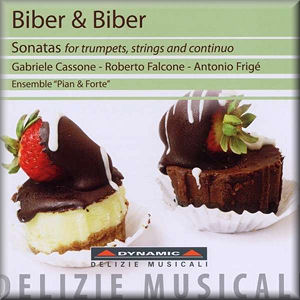 |
 |
|


alternatively
CD: MDT
AmazonUK
|
Biber & Biber - Sonatas for trumpets, strings
and continuo
Carl Heinrich von BIBER (1681-1749)
Sonata for 4 trumpets, strings, timpani and bc [05:11]
Heinrich Ignaz Franz von BIBER (1644-1704)
Sonata IV a 5 for trumpet. strings and bc in C (C 117) [04:33]
Sonata representativa for violin and bc in A (C 146)* [11:42]
Carl Heinrich von BIBER
Sonata Paschalis for 4 trumpets, strings and bc [04:08]
Sonata for trumpet, strings and bc in C [07:12]
Sonata for trumpet, strings and bc in D [06:30]
Sonata for trumpet, strings and bc in C [05:30]
Heinrich Ignaz Franz von BIBER
Partia V for two violins and bc in g minor (C 66) [11:03]
Sonata VII a 5 for two trumpets, 2 violins and bc (C 120) [06:34]
Carl Heinrich von BIBER
Sonata for 4 trumpets, strings, timpani and bc [06:10]
 Gabriele Cassone (natural trumpet), Roberto Falcone (violin) (*)
Gabriele Cassone (natural trumpet), Roberto Falcone (violin) (*)
Ensemble 'Pian & Forte'/Antonio Frigé
rec. 19-20 November 1998, Genova, Italy DDD
 DYNAMIC DM8001 [68:47]
DYNAMIC DM8001 [68:47] 
|
|
|
Heinrich Ignaz Franz von Biber is one of the most important
representatives of the German violin school which developed
in the second half of the 17th century. In his various jobs
in Bohemia and Austria he wrote a large number of pieces for
violin solo as well as music for string ensemble. He also composed
music with parts for one or two trumpets. The two sonatas on
this disc are from a collection which was printed in 1676 under
the title Sonatae tam aris quam aulis servientes (Sonatas
as much for the altar as for the table). It is not quite clear
when exactly these sonatas were written and where they were
to be performed. From 1668 to 1670 Biber was at the service
of the bishop of Olmütz, Karl Leichtenstein-Castelcorno, and
in the musical archives of his chapel some of the sonatas have
been preserved in manuscript. The famous Bohemian trumpeter
Pavel Vejvanovský was also at the service of the bishop, and
Biber could well have been inspired by his great skills, as
the trumpet parts are technically demanding. It is also possible
that he wrote these sonatas when he was already in the service
of the Archbishop of Salzburg, Maximilian Gandolph von Khuenburg,
to whom they are dedicated.
Biber had 11 children, of whom only four survived childhood:
two sons and two daughters, who were all skilled musicians.
Carl Heinrich was already taking part in the performance of
two of his father's schooldramas at the age of 11. In 1704 he
travelled to Rome, apparently to extend his skills in violin
playing. Like his father he worked at the court in Salzburg.
In 1714 he became vice-Kapellmeister and in 1743 Kapellmeister.
He composed exclusively for the church, and his 31 sonatas were
indeed written for ecclesiastical use. The Sonata Paschalis
is one of the sonatas which bears witness to that. It begins
with a grave for strings alone, and is followed by a
festive presto. Here as well as in the two other sonatas
with four trumpet parts one of the trumpets gets a solo role,
whereas the other trumpets and the timpani only play in tutti
episodes. The three sonatas for one trumpet - called sonata
ŕ clarino solo - are all in three movements, fast-slow-fast.
Unlike his father Carl Heinrich wasn't a composer of high reputation.
That said, these sonatas are nice works, and will certainly
have met the requirements of instrumental music for the liturgy.
We return to Heinrich Ignaz Franz. Two of his pieces for strings
alone are also included. Today these are available in various
recordings, but that probably wasn't the case at the time this
disc was first released. The Sonata representativa is
an early specimen of a piece in which the violin imitates animals,
like the nightingale, the hen and the cat. This was the kind
of stuff representatives of the German violin school were very
fond of. Here Biber follows in the footsteps of Carlo Farina
(c1604-1639), the Italian violin virtuoso who for a number of
years worked in Dresden and greatly inspired German violinists.
He also imitated various animals in his famous Capriccio
stravagante.
This piece as well as the Partia V (from Harmonia
ariosa-artificiosa) are available in a number of recordings.
In some of these they are definitely performed better than on
this disc. The addition of percussion in the Sonata representativa
doesn't make things any better - on the contrary. On the whole
I am not that impressed by the string playing of the Ensemble
'Pian e Forte'. Technically it is alright, but the interpretation
is rather bland and not very engaging. The playing of Gabriele
Cassone is this disc's main attraction, and the reason to recommend
it. One may be surprised by the technical perfection of Cassone's
playing, in particular in regard to intonation. After all, the
natural trumpet has the reputation of being very hard to play
in tune. But it should be noted that, although this is not mentioned
in the booklet, Cassone - like most modern players of the natural
trumpet - uses an instrument which has fingerholes in order
to improve the intonation. Even with such 'unhistorical' additions
the natural trumpet is hard to play correctly, and therefore
Cassone's performances deserve particular praise.
The booklet contains liner-notes in English. These could have
been more informative. In particular about Carl Heinrich and
his sonatas we get very little. The track-list omits the keys
of any of the pieces, information about scoring is inaccurate,
and the first sonata should include a "clarinet".
The source of Partia V is not mentioned. The fact that
this disc is a reissue - probably at budget price - is no excuse
for a sloppy booklet.
Johan van Veen
http://www.musica-dei-donum.org
https://twitter.com/johanvanveen
|
|

